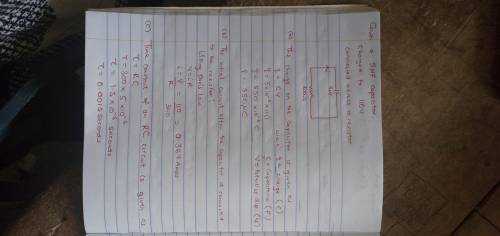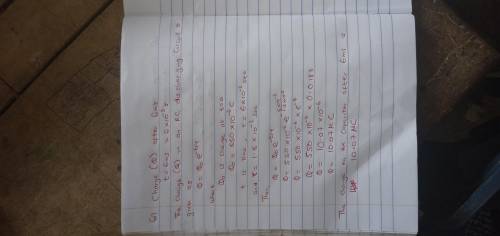
A 5-mu or micro F capacitor is charged to 110 V and is then connected across a 300-ohm resistor. What is the initial charge on the capacitor? C [2.5 points] 0 attempt(s) made (maximum allowed for credit = 5) [after that, multiply credit by 0.5 up to 10 attempts] What is the initial current just after the capacitor is connected to the resistor? A [2.5 points] 0 attempt(s) made (maximum allowed for credit = 5) [after that, multiply credit by 0.5 up to 10 attempts] What is the time constant of this circuit? s [2.5 points] 0 attempt(s) made (maximum allowed for credit = 5) [after that, multiply credit by 0.5 up to 10 attempts] How much charge is on the capacitor after 6 ms? C

Answers: 1


Another question on Physics

Physics, 21.06.2019 19:50
How can one distinguish breccia from conglomerate? a. breccia contains angular clasts and conglomerate contains rounded clasts. b. breccia contains rounded clasts and conglomerate contains angular clasts. c. different minerals cement breccia than cement conglomerate. d. breccia contains sand and conglomerate contains silt.
Answers: 1

Physics, 21.06.2019 23:00
Follow these directions and answer the questions. 1. set up the ripple tank as in previous investigations. 2. bend the rubber tube to form a "concave mirror" and place in the ripple tank. the water level must be below the top of the hose. 3. generate a few straight pulses with the dowel and observe the reflected waves. do the waves focus (come together) upon reflection? can you locate the place where the waves meet? 4. touch the water surface where the waves converged. what happens to the reflected wave? 5. move your finger twice that distance from the hose (2f = c of c, center of the curvature) and touch the water again. does the image (the reflected wave) appear in the same location (c of c)? you may have to experiment before you find the exact location. sometimes it is hard to visualize with the ripple tank because the waves move so quickly. likewise, it is impossible to "see" light waves because they have such small wavelengths and move at the speed of light. however, both are examples of transverse waves and behave in the same way when a parallel wave fronts hit a curved surface.
Answers: 1

Physics, 22.06.2019 13:10
Which of the following are used in an electrochemical cell? a. electrodes b. electrolyte c. terminals d. all of the above
Answers: 3

Physics, 22.06.2019 15:30
What are the north and south poles of a solenoid change with?
Answers: 1
You know the right answer?
A 5-mu or micro F capacitor is charged to 110 V and is then connected across a 300-ohm resistor. Wha...
Questions


Mathematics, 21.08.2019 20:30

Biology, 21.08.2019 20:30



Social Studies, 21.08.2019 20:30

Biology, 21.08.2019 20:30

History, 21.08.2019 20:30

Chemistry, 21.08.2019 20:30



Biology, 21.08.2019 20:30

Mathematics, 21.08.2019 20:30


History, 21.08.2019 20:30

Social Studies, 21.08.2019 20:30

Spanish, 21.08.2019 20:30

Spanish, 21.08.2019 20:30


History, 21.08.2019 20:30





